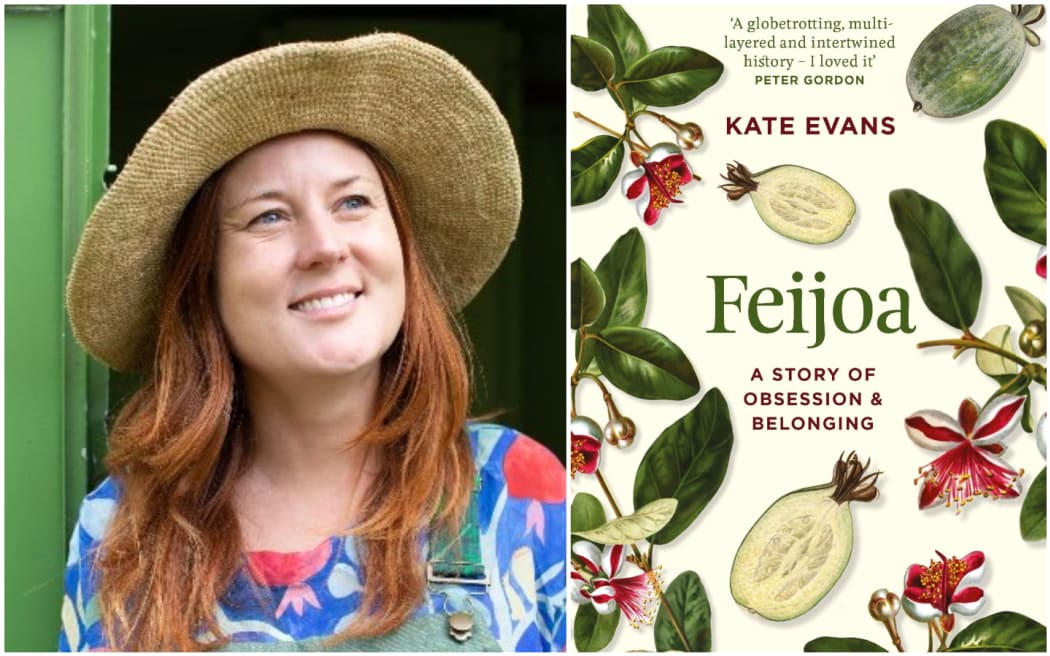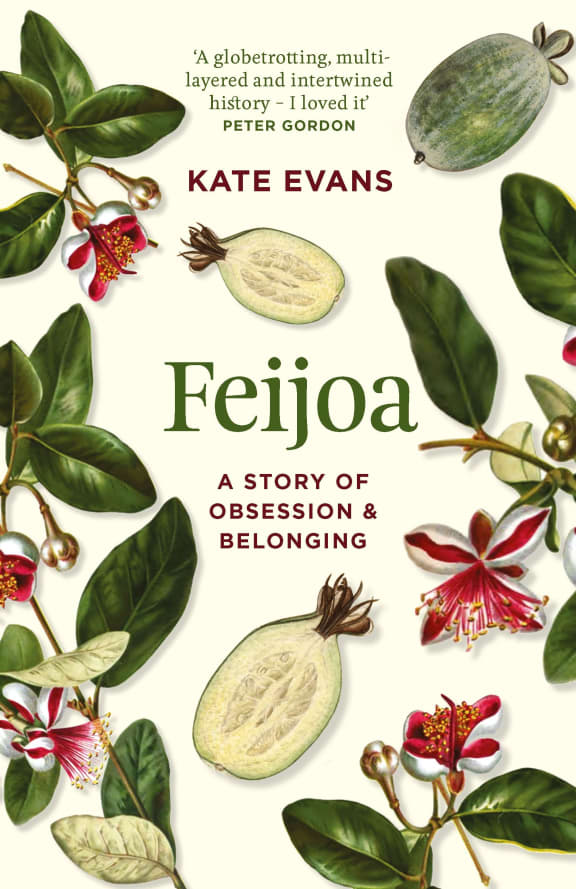Kate Evans' obsession with the feijoa has taken her all over the world to discover the origins and horticultural journey of the fruit Kiwis have taken to their hearts.
Evans, an award-winning journalist and regular contributor to New Zealand Geographic, spent a decade talking to scientists, historians and horticulturalists on four continents to trace the feijoa back to its Brazilian beginnings.
Her new book - Feijoa: A Story of Obsession and Belonging - is part-science writing, part-personal memoir, and seeks to uncover why out of all places, New Zealand took in the fruit as its own.

Photo: Kate Evans
Her love of the fruit started in childhood, she told Nine to Noon.
“We had a feijoa hedge that encircled the orchard at home where I was growing up, and my sisters and I would come home from school, walk down the gravel driveway, chuck off our school bags and start hoeing into the feijoas under the tree, cutting them in half with a knife and eating them out with a spoon. A classic New Zealand childhood experience.”
After a spell working overseas, she returned to New Zealand and her love affair with the feijoa was reignited, she says.
“I moved back home to New Zealand and at the end of 2013. I just turned 30. I'd been living overseas for 12 years. And I was really excited to be here for a whole feijoa season.
“That year I started to wonder why was it that this was the taste of home for me when it came from South America.”
For New Zealanders it’s a meaningful fruit, she says.
“I just got really curious. What has this fruit meant to other people in other parts of the world? And other times? And how did it get to be the way that it was like? Why is it green? And why is it so fragrant? Why does it fall to the ground when it's ripe? What are the evolutionary reasons behind this?
“One question led to another.”
A Spanish speaker who had spent time in South America before, she travelled to Brazil and linked up with a scientist in the south of that country.
“He and some of his students took me up into the highlands, which is where they think the evolutionary centre of origin is for the feijoa.
“Where it evolved is this amazing forest, the trees there are araucaria trees, which are related to the Norfolk pine, they're really weird-shaped, super ancient, they have these great big nuts that formed the basis of the food supply for the indigenous peoples there.”
The Southern Jê lived there over 4000 years’ ago and the evidence suggests feijoa formed part of their diet, she says.
“They took me to this archaeological site, which was about 1500 years old, there's a series of houses surrounded by araucaria trees and all of these fruit trees.
"Heaps of feijoas planted almost like in lines and then all of these other fruiting trees that are relatives of the feijoa, in that forest there's a whole bunch of different, cool, delicious fruits that are related to feijoas.”
Next her journey took her to France, to the former villa of a French landscape gardener named Edward Andre.
“He was the first person to take living feijoas out of South America and start growing them somewhere else.”
Andre went to Uruguay in the 1890s and at some point on that trip and encountered the feijoa which he brought back to the south of France and planted in his garden, she says.
“He had this beautiful house and this big garden with all kinds of different plants from all over the world, which was a real trend on the French Riviera at the time, and he started growing the feijoa, and seven years later, it fruited for the first time, and he got to eat his feijoa.
“And then he wrote an article for that was published in newspapers all around the world introducing this new fruit, and he started selling seedlings of it.”

Photo: Hatchette
Evans tracked down the villa near Cannes, which was still intact. While the garden did have feijoas, the original one he had planted was no longer there.
Her research then took her to Berlin.
“A guy called Friedrich Sellow, a Prussian-German botanist, he travelled around Brazil on the back of a mule for many years until he eventually drowned in a river.
“He has all these amazing diaries and sketches of the people that he met and the plants and the animals that he saw. And I wanted to see those and I wanted to see the specimen that represents the feijoa for science, which is in the Berlin Herbarium."
Next, she went to Italy.
“Since I couldn't find Andre’s original feijoa, I was trying to find the oldest feijoa I could find that was actually dated and ended up finding that just across the French-Italian border in the Hanbury Garden, which has this beautiful garden that kind of tumbles down to the Mediterranean.
“And there's a huge, big rambling feijoa in there that was definitely there in 1912 and possibly earlier. I'm sure there are older feijoa trees, but that's the oldest one I could date.”
There was a time when nurserymen in California were convinced the feijoa could be the fruit of the century, she says, and they started to select and breed the best specimens for commercial release.
“A few of those guys started to select varieties so that basically you grow a whole bunch of feijoas from seed and you see which ones have big fruit or delicious fruit or lots of fruit, and you choose those ones.
"And then breeding is when you then try to cross them and get particular traits. But the first step is just selecting the one that is doing really well. And then you can take a clone of that by a cutting or a graft.”
The first varieties selected in California found their way to New Zealand in the early 1920s, which is when Hayward Wright enters the story.
“He basically had a giant orchard on the Avondale Peninsula in Auckland, that whole area, which is now a suburb, was kind of a garden. He was a pretty cantankerous old guy by all accounts, but he really loved his fruit.
“And he really loved feijoas and when I was looking back in the papers, past records for old newspaper articles about for feijoa was there were heaps by him talking them up.”
It was Wright who in the ‘20s and the ‘30s popularised the fruit in New Zealand.
“He really helped to make the feijoa famous in New Zealand and he also released a few varieties of feijoa that people could buy.”
It never became a commercially viable fruit, but is the people’s fruit in New Zealand, Evans says.
“There was a Spinoff article a few years ago which referred to the feijoa as New Zealand's most socialist fruit.
“I think that's one of the reasons why we love it so much in New Zealand and why I think it has a special meaning and why I wrote about feijoas and didn't write about tamarillo or persimmons. They don't have this element of gifting that the feijoa has.
“The fruit doesn't store well and then is extremely abundant for a few weeks a year and gets to the point where you can't use them anymore, but you don't want to waste them, you can't store them, so you give them away.”

